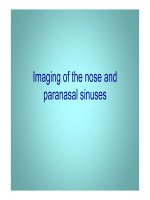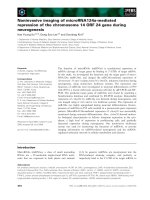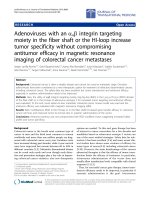Imaging of CNS infections
Bạn đang xem bản rút gọn của tài liệu. Xem và tải ngay bản đầy đủ của tài liệu tại đây (3.37 MB, 75 trang )
Imaging of CNS infections
DR MILI DUTTA
protocol
Axial T1W
Axial T2W TURBO
Axial
FLAIR/Coronal
Coronal/sag T2W
CE—TIW
TIW Same parameter settings pre/post contrast
3 D MP-RAGE(GRE) –THIN SLICES/ANY
PLANE/GOOD GREY WHITE DIFF
DWI
V
SENSITIVE TO VENTRICULITIS
ABSCESS VS TUMOR
T2w/flair
Infarct
Edema
Capsular
rim
Perivent--FLAIR
T1w/c
Meningeal
Effusion
vs empyema
Choroid plexitis—diff on FLAIR/DWI
because BRIGHT intravent contents
make it diff to detect
Comparison of MRI Sequences to Detect
Ventriculitis AJR 2006; 187:1048-1053
TUBERCULOSIS
starts subpial / subependymal cortical focus (Rich focus),
GRANOLOMA ERODES INTO SAS LEPTOMENINGITIS
OBSTRUCTS FORAMEN
LUSHAKA/MAGENDIE—
OBSTRUCTIVE HYDROCEPHALUS
NON OBS
GRANULOMA
ABSCESS
CEREBRITIS
PACHYMENINGITIS
VASCULITIS (THALAMOSTR
//THALAMOPERFORATE
INFARCT
CT
CECT--leptomeningeal
and basal cistern
enhancement.
EPENDIMITIS- linear perivent enhancement
VENT DIL (eg, third and fourth vent) due to
hydrocephalus
low-attenuating focal infarcts deep gray-matter
nuclei, deep white matter, -due tovasculitis.
Parenchymal cerebritis – hypoatt/ min
enhancement.
Parenchymal tuberculomas
--. Noncaseating granulomas are homogeneously
enhancing lesions
-- Caseating granulomas are rim enhancing
--miliary pattern with multiple tiny nodules scattered
throughout the brain.
All surrounded by hypoattenuating edema.
MR
T1W--prominent leptomeningeal and basal cistern enhancement.
ependymitis, linear periventricular enhancement.
Ventricular dilatation due to hydrocephalus
. Deep gray-matter nuclei, deep white matter, and pontine infarctions
resulting from vasculitis are hyperintense on T2-weighted images.
DWI -- early ischemic lesions when T2 N The primary differential
diagnoses are fungal meningitis, bacterial meningitis, carcinomatous
meningitis, and neurosarcoidosis.
Parenchymal cerebritis hyperintensity with little or no enhancement
on T2-W
tuberculomas hypo/HYPER on T2-weighted images.
Noncaseating granulomas homogeneously enhancing//. Caseating
granulomas are rim enhancing. //miliary pattern with multiple tiny,
enhancing nodules scattered throughout the brain. -- surrounded by
hyperintense edema on T2-weighted images. The differential
diagnoses include fungal infections, bacterial infections,
neurocysticercosis, and cerebral metastases.
MRS(single-voxel )TO D/D neoplasms.
-- elevated fatty-acid. Due to necrosis of the waxy walls of mycobacteria
within the granuloma
--. The lactate peak -- anaerobic glycolysis
INCREASED LACTATE,
DECREASED NAA,CHOLINE
THICK WALLED ABSCESS
MULTIPLE ENHANCING TUBERCULOMAS
vasculitis thalamoperforating a –
infarct basal ganglia/int capsules
Low SI rim (free oxygen radicals DUE TOinflammatory
process decrease T2 values +vasogenic edema
TUBERCULOMA
references
Tuberculosis,
CNS: Peter D Corr et al
www.emedicine.com
www.aids-images.ch
INTRAMEDULLARY
TUBERCULOMA
Brain abscess
Brain Abscess - pathology
Location
temporal
> frontal > other lobes
>10%
are multiple
Stages - based on histologic findings
1.
Early cerebritis - poorly demarcated from
surrounding brain
2. Late cerebritis - reticular marix (collagen
precursor) and developing necrotic center
3. Early capsule formation - neovascularity,
necrotic center, developing capsule
4. Late capsule formation - collagen capsule,
necrotic center, gliosis surrounding capsule
Abscess – MRI presentation
MRI
presentation also varies with capsule
formation
Early Cerebritic stage – hyperintense in T2 with
poor contrast enhancement on T1.
Later Cerebritic Stage – central region of necrosis
is hyperintense to brain on T2, rim is isointense to
mildly hyperintense on T1. The capsule
enhances with contrast.
Early and Late Capsule Stages – Capsule is
easily visible on unenhanced scans as a well
deliniated isointense to slightly hyperintence ring
with becomes hyperintense with contrast on T1.
Capsule is hypointense on T2
Abscess – CT presentation
CT appeareance
dependent on stage
Cerebritic stage – thick diffuse ring of
enhancement, further diffusion on contrast into
central lumen or lack of decay of contrast on
delayed scan 30-60 minutes later.
Capsular stage – faint rim present on pre
contrast CT. (Necrotic center with edematous
surrounding brain makes the collagen capsule
easier to see.). Thin ring on enhancement and
there is decay of enhancement on delayed
scans.
Multiple abscesses in a 6 year
old
Subdural Empyema - evaluation
CT of
head both with and without contrast
LP - hazardous - risk of transtentorial
herniation
Location
convexity 70-80%
falcine 10-20%
32/10,000 autopsies
Mixed Abscess Location









